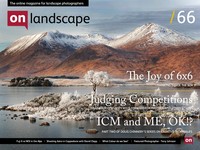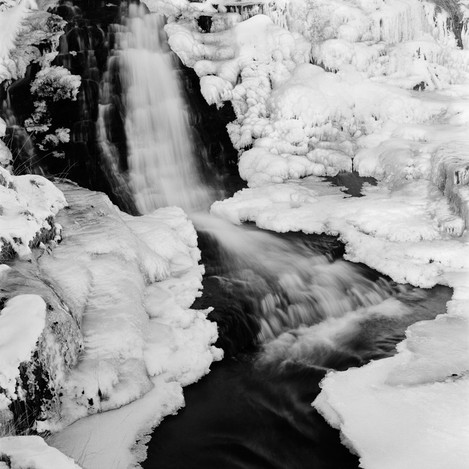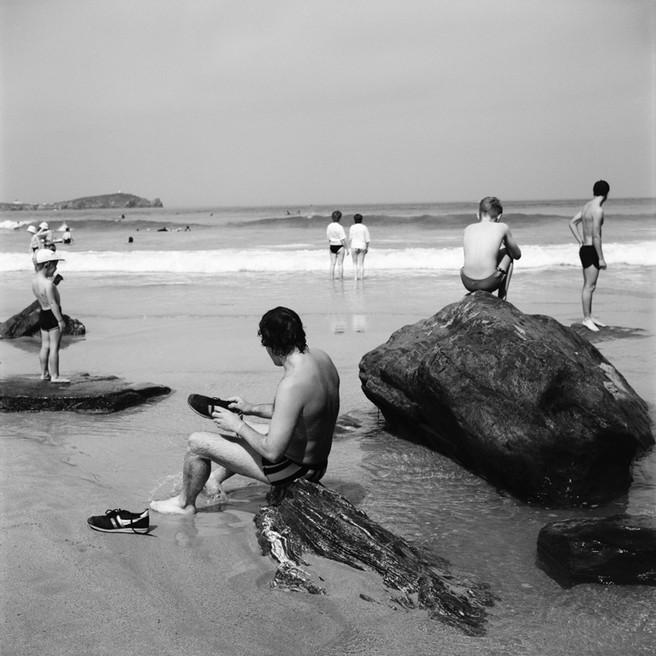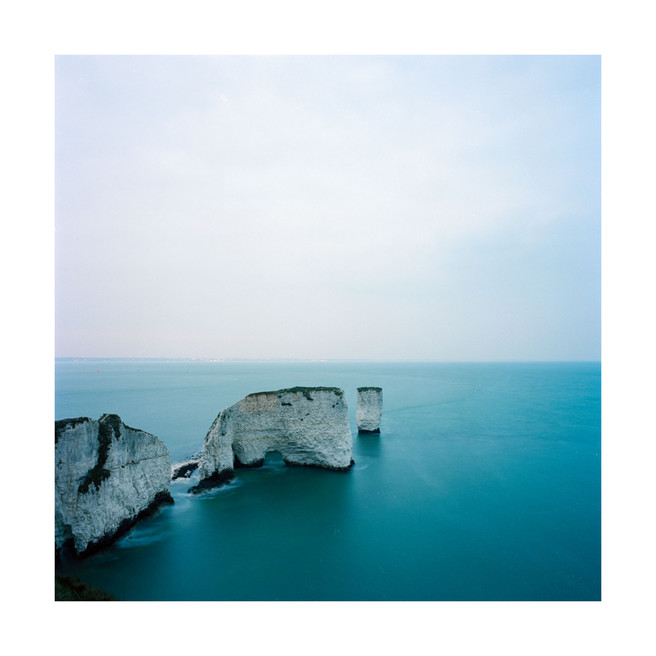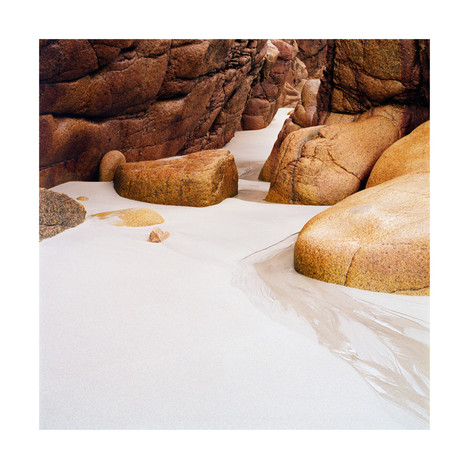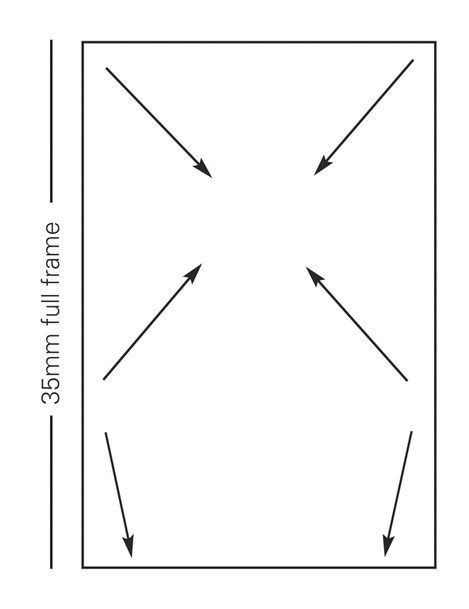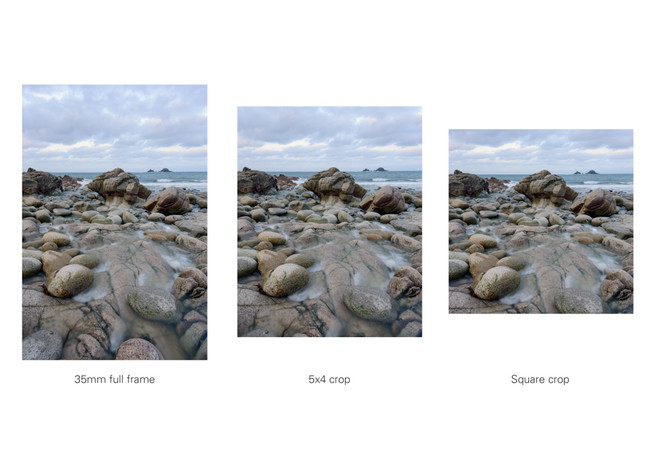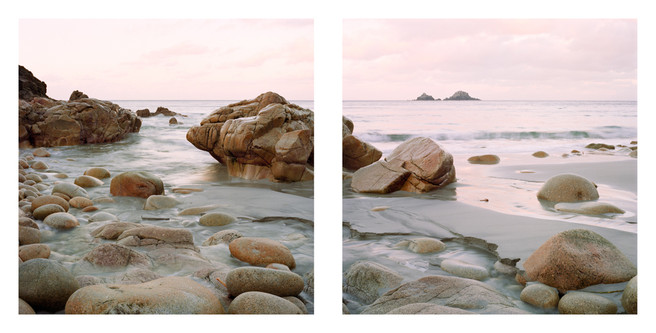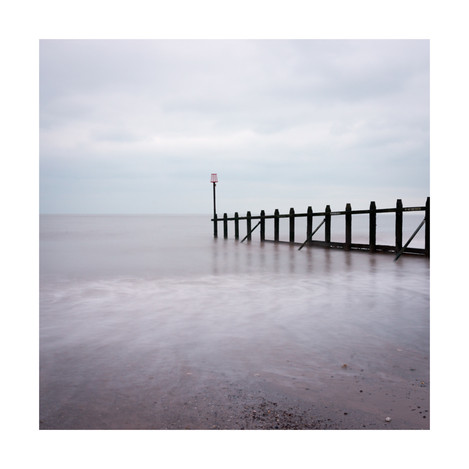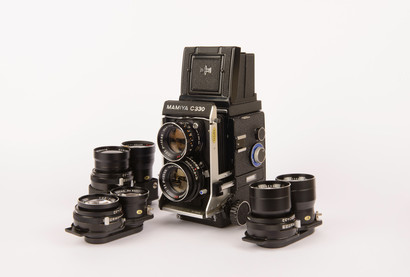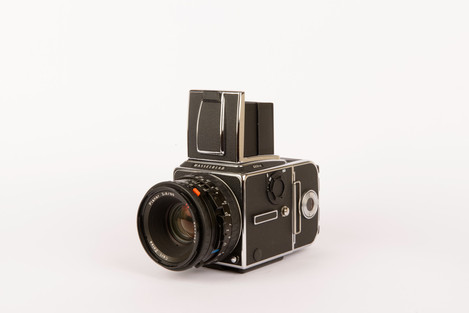Thinking Inside the Box

Andrew Nadolski
Andrew Nadolski is a professional designer and photographer based in Exeter. His series 'The End of the Land' has been exhibited in museums and art galleries across England and has been published as a book by Headon House.
It was when I was at art college that I was first introduced to ‘the square’ as a format for making images; I bought a second-hand Minolta Autocord (Minolta’s cheaper version of the classic Rolleiflex twin lens camera) from an older student for £40 and entered the world of 120 film. Up to that point, apart from battling with a huge monorail studio camera, I had only worked with 35mm cameras, so a 6x6 twin lens reflex felt ‘large format’ enough and I could use it successfully hand-held as well as on a tripod. Looking down onto the ground glass screen was a revelation. The simple fact of not having the camera glued to my eye allowed me to work in a completely new way. And the square... it was just so ‘different’ to my previous image making. My early student photography, admittedly more documentary in approach, had been shot to edit, working instinctively and selecting pictures from countless contact sheets. The 35mm viewfinder felt like a replication of how I saw the world, and I suppose was a natural visual format to work with whilst learning the technical aspects of photography.
With my 6x6 camera the limit of 12 exposures on a roll helped slow down my over exuberance with the shutter release and I began to make more considered pictures. I found that by alternating between using the flip-up magnifier to check details, and then ‘stepping back’ to see the full image on the ground glass screen, I could pre-visualise the image as the print I was then going to make. The left to the right transposition of the viewed image on the ground glass helped enormously in improving my compositional skills; one of the oldest tried and trusted methods of achieving balanced composition is to see the image mirrored. 5x4 or 10x8 users go one stage further and would argue nothing beats seeing the image upside down as well as back to front, as the ultimate way to compose.
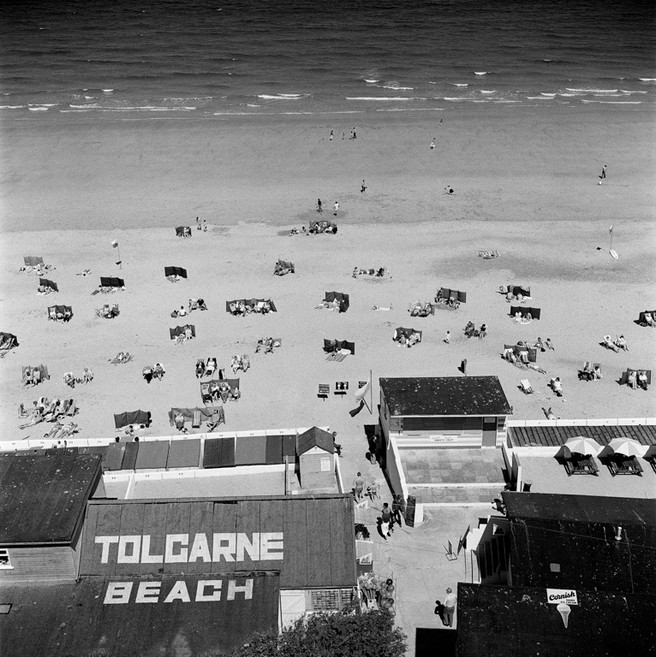
Tolcarne Beach 1985 from my long running series on Newquay - all the pictures were taken hand-held with Twin-lens reflex cameras
When I began making 6x6 images I started to consciously consider the edges of an image. This may sound strange but when working with 35mm cameras (and with the camera to my eye) I would compose from the centre of the frame out. I suppose it is a natural, instinctive documentary approach with your eye following the subject but when I worked with my TLR I found I was often working from the edges in, considering the frame edges and corners as integral parts of the composition. A lot of artists and photographers talk about various compositional ‘devices’ like the rule of thirds and creating S shapes within the image, but just as important are the edges. I sometimes think of the edges (and corners) of an image as acting like the flippers on some virtual pinball machine. As you visually read around the image ‘decoding it’ (something David Ward talked about in issue 31) it is the job of the edges of the image to ‘keep the ball in play’ so to speak and not let the eyes leave the frame.
I think the square when used successfully, can facilitate an increased sense of balance and visual flow because of its innate symmetry as a format. In his autobiography, my great hero the musician Frank Zappa, gave a very succinct description of what the physicality of a piece of ‘art’ is. It went something like this - ‘as an artist what you are doing is putting a frame around something that you have made/seen/composed and saying to the viewer/listener - ignore what is outside this frame, concentrate on this, this is something interesting’. It is the edges after all that form the boundaries of ‘our art’, that separates it from the rest of the world and the space around it.
If you think of how we look at the world every day, our eyes constantly travel from side to side, far more than up and down. With a moving image, we prefer this panoramic vision - it feels more natural. 16:9 (close enough to 35mm) was found after much research to be the optimum format for television screens. But when I am making my landscape images I want to engage the viewer, to show something different to their natural visual experience of the world. I feel shooting square seems to be ‘different enough’, yet not feel contrived and a series of square images work harmoniously together when exhibited or published as a sequence in a book. When I shoot with a 35mm camera (used horizontally) there can be a temptation to simply replicate a view I have seen standing at a particular spot at a particular point in time - the ‘vista approach’.
Because it is different from our day-to-day view of the world composing a square image demands that bit more from the photographer. Pre-visualising a square forces your vision in, minimising the constant wandering of our eyes from side to side, ignoring our peripheral vision. It also forces the photographer to seek a balance between the various elements of the composition. As you go wider in the horizontal there is a proportionate increase in the amount of the foreground potentially included in the frame. The foreground has to be carefully considered and included in the overall compositional balance, and the square can help avoid its potential over dominance. This is something that 35mm format shooters really need to be conscious of when making portrait format images using wide angle lenses. If not handled carefully, resulting images can pull the viewers eyes in two opposing directions with the bottom quarter unbalancing a visual flow and pulling the eyes down and out of the frame. The following simple diagram should help explain what I mean.
If there are clouds at the top of the frame this can lead to a situation where the viewers eyes are pulled in an additional direction out of the frame. I took the image on the following page the other day to illustrate these points. It was shot with a 14-24 zoom at 21mm to come close, when cropped square, to the field of view I was getting with my Hasselblad and 50mm.
Experienced 5x4 photographers like Joe Cornish and David Ward avoid this potential visual imbalance by using the effect of ‘looming’. It allows the inclusion of close-up foreground detail without the vertigo inducing effect of your eyes falling out of the bottom of the frame. This was covered in issue 55 of OL.
I think the ‘slowing down’ and ‘thinking more’ approach that making square images engenders ultimately helps me make more rewarding pictures. The square, because of its inherent visual balance allows me to use negative space as a strong visual element. Going one stage further, I find I really enjoy the challenge of making dyptchs and tryptchs - composing a single square picture, then making adjoining ones that work well individually but combined together make something visually stronger.
When I make square format images with my D800, I find visualising the square in-camera a bit of a struggle to see accurately. I prefer the approach of composing a square image in-camera rather than ‘finding it later’ in Photoshop. The camera has a wonderful 5x4 crop mode that greys out part of the viewfinder, it is such a shame that Nikon didn’t include a 1:1 option as well. A 1:1 crop mode exists on some smaller format cameras with their accompanying smaller viewfinders and limited resolution when cropped to a square but not on a camera with megapixels to spare. The D800 has more than enough resolution to make pin sharp 20x20 inch exhibition prints but it is not easy to visualise as well with as the cheapest twin lens reflex camera. Annoyingly Nikon don’t allow the focus screen to be changed in the D800 otherwise I would have had one etched with square crop. Oh well there is always the tried and trusted piece of black card with a square hole in it...
For anyone interested in exploring the analogue world of 6x6 cameras I have compiled a brief overview of some of the various cameras I use. Some of them can be purchased second-hand for relatively small amounts. There are three types of 6x6 format cameras available; twin-lens reflex, single-lens reflex and rangefinder, each has its own virtues.
Twin-lens reflex
As I said at the start of this article, my first 6x6 camera was the Minolta Autocord. This is mechanically very simple, differing from the Rolleiflex in that focussing is achieved using a lever under the taking lens. I found this, coupled with a cheap L bracket, enabled me to work handheld and very quickly. I used an Autocord for all my early documentary landscapes of the beaches and tourists at Newquay. The only thing missing from the camera is any built-in parallax correction or indicator. This can require a bit of calculation on the photographers part when working close-up. A used Autocord can be found for around £100.
Mamiya managed to build a complete system, based on the twin lens design with interchangeable lenses which ranged from a relatively wide 55mm to a 250mm telephoto, as well as numerous accessories. The C330 and cheaper C220 were often the workhorse for wedding photographers but shouldn’t be overlooked for landscape work. The cameras use bellows style focussing which allows viewing and taking lenses to be mounted on lens plates and therefore to be interchangeable. The Mamiyas are considerably larger than a Rolleiflex or Minolta, but they do the job and I find their relative ugliness rather attractive. My favourite lens is the 105DS, which has an adjustable aperture built into the viewing lens to judge depth of field when the taking lens is stopped down. One of the very useful accessories to seek out is the Paramender, which adjusts the height of the camera when used on a tripod to compensate for parallax between the viewing and the taking lens.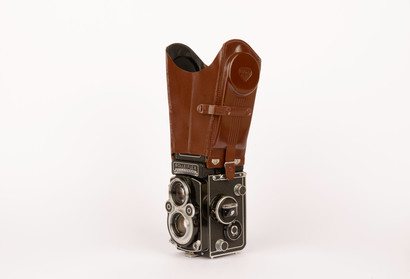 The best model to look for is the C330f, which was better built than the C330s which replaced it. A C330f with 80mm standard lens can be found from £200 upwards.
The best model to look for is the C330f, which was better built than the C330s which replaced it. A C330f with 80mm standard lens can be found from £200 upwards.
A classic Rolleiflex can be a joy to shoot with. Over the many years it has been in production there have been numerous models from the stripped down Rolleicords with their simpler Tessar lenses to the more luxurious later 2.8f and 3.5f models. My favourite is the 3.5f with its 75mm lens. I prefer this to the rather front-heavy 2.8f with it’s 80mm lens. I find a 75mm standard is the perfect focal length for a 6x6 camera and landscape work. Rollei did make wide-angle and telephoto versions though these are rare second-hand and the wide is extremely expensive. To compensate for the fixed lens nature of the camera Rollei manufactured a number of ingenious accessories to expand the camera use from matching close-up lenses, focal-length adjusters (Mutars) to various viewing accessories. My favourite is the ‘Biggles’ style folding leather bino-hood. Good condition Rolleiflexs can be very expensive as they are very collectable. They can be like owning an expensive classic car - a pleasure to work with but there are far cheaper ways of getting from A to B.
One of the main advantages of using TLRs is that they all use leaf shutters making them very quiet in operation plus relatively easy to hand-hold.
Single-lens reflex
6x6 SLRs are true system cameras. There are (were) three main choices: Rolleiflex, Bronica and Hasselblad. I worked for many years with a Bronica SQA and found the later PS lenses to be optically excellent and could give the considerably more expensive Zeiss lenses a good run for their money. You can pick up a complete used SQA with wide-angle, standard and telephoto for prices starting at £500 - that is considerably less than you would pay for a good quality Hasselblad 503CW without a lens or film back.
Hasselblad - the camera that went to the moon! Hasselblad have certainly milked that one for all its worth with their ridiculous rebranded Sony Nex7 - the Lunar and now the rebranded RX100 - the Stellar. However the core 500 series or V System is a camera that will just keep on going. Its non-reliance on electronics means it can be kept alive by excellent independent repairers like Douglass Fairbanks (ex Hasselblad) at Classic V.
As well as the conventional ‘body with a mirror’ design of the 500 series or more complicated focal plane shutter models, Hasselblad made a couple of less well known cameras that allowed movement. The Arc Body had three dedicated interchangeable lenses. 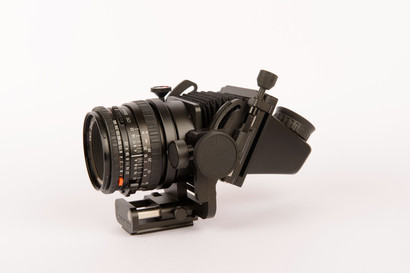 I owned an Arc Body for a while and found the ‘standard’ 45mm wide angle to be excellent but the extreme wide 35mm was not in the same league.
I owned an Arc Body for a while and found the ‘standard’ 45mm wide angle to be excellent but the extreme wide 35mm was not in the same league.
The Flexbody is a far more useful addition to a regular ‘500 as it allowed the use of regular Zeiss lenses. Shift was very limited but a Flexbody turns any lens into a tilt one. A Flexbody can be used on its own for landscape work, though the shooting process is slightly slower due to the fact the film back has to swapped for a focussing screen for composition mind you, that approach has never hindered large format photographers. It can also be carried alongside a normal body, for times when a tilt lens is required.
A used Flexbody can be had from around £1,000 but beware correction slides are needed when tilt is used so are essential to find included with the camera. The RMX viewfinder supplied with the camera as a kit is often sold separately and can be sold for ridiculous amounts.
Hasselblad also made a series of ultra wide cameras, the SWC range with fixed 38mm Biogon lenses. An early SWC can sometimes be found for around £1,000 but later models sell for many times that.
Rangefinders
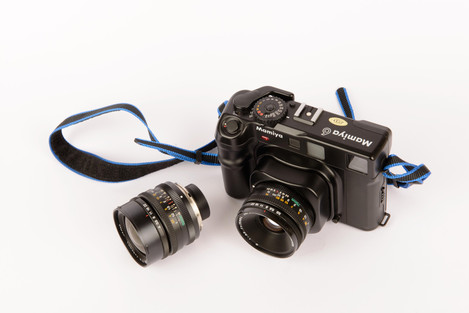 Over the years there have been numerous 6x6 rangefinder cameras some with collapsible lenses. The last true 6x6 fixed format rangefinder was the Mamiya 6. The 6 was replaced by the Mamiya 7 but now sells for far more second hand than its later sibling. There are three lenses available for the 6: a 50mm, reportedly one of the sharpest lenses ever made; a standard 75mm and a slightly less useable 150mm. One of the great strengths of the ‘6 is the ability to collapse the lenses into the camera body reducing its overall size. The advantage the 6 had over the 7 is the camera didn’t need an additional viewfinder to work with the 50mm wide angle. Good condition 6’s are hard to find as photographers tend to hold onto them. They are probably the ultimate in carry-around 6x6 landscape cameras.
Over the years there have been numerous 6x6 rangefinder cameras some with collapsible lenses. The last true 6x6 fixed format rangefinder was the Mamiya 6. The 6 was replaced by the Mamiya 7 but now sells for far more second hand than its later sibling. There are three lenses available for the 6: a 50mm, reportedly one of the sharpest lenses ever made; a standard 75mm and a slightly less useable 150mm. One of the great strengths of the ‘6 is the ability to collapse the lenses into the camera body reducing its overall size. The advantage the 6 had over the 7 is the camera didn’t need an additional viewfinder to work with the 50mm wide angle. Good condition 6’s are hard to find as photographers tend to hold onto them. They are probably the ultimate in carry-around 6x6 landscape cameras.
P.S. Apologies for the pun in the title - I couldn’t resist it though I may be showing my age.
- One of my first landscape images taken about a month after I aquired the Minolta Autocord in 1985
- Tolcarne Beach 1985 from my long running series on Newquay – all the pictures were taken hand-held with Twin-lens reflex cameras
- Great Western Beach, Newquay, 1988

